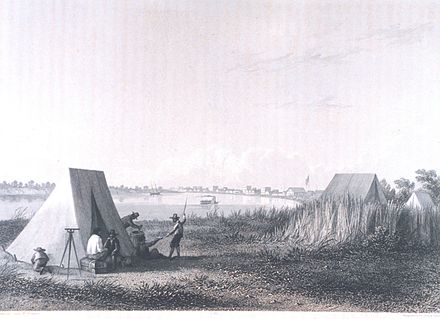Brownsville (/ˈbraʊnzˌvɪl/) is a city in the U.S. state of Texas and the seat of Cameron County, located on the western Gulf Coast in South Texas, adjacent to the border with Matamoros, Tamaulipas, Mexico. The city covers 145.2 sq mi (376.066 km2), and had a population of 186,738 at the 2020 census.[9] As of the 2020 U.S. Census, it is the 139th-largest city in the United States and 18th-largest in Texas. It is part of the Matamoros–Brownsville metropolitan area. The city is known for its year-round subtropical climate, deep-water seaport, and Hispanic culture.
The city was founded in 1848 by American entrepreneur Charles Stillman after he developed a successful river-boat company nearby. It was named for Fort Brown, itself named after Major Jacob Brown, who fought and died while serving as a U.S. Army soldier during the Mexican–American War (1846–1848). As a county seat, the city and county governments are major employers. Other primary employers fall within the service, trade, and manufacturing industries, including a growing aerospace and space transportation sector. It operates international trading through the Port of Brownsville. The city experienced a population increase in the early 1900s, when steel production flourished.
Due to significant historical events, the city has multiple houses and battle sites listed under the National Register of Historic Places. The city played a primary role in the Mexican–American War with the Siege of Fort Texas and the first engagements of the war: The Battle of Palo Alto and The Battle of Resaca de la Palma. Several key events of the American Civil War took place in the city, such as the Battle of Brownsville and the Battle of Palmito Ranch. The city was also involved in the Texas Revolution. Brownsville's idiosyncratic geographic location has made it a wildlife refuge center. Several state parks and historical sites are protected by the Texas Parks and Wildlife Department.
Brownsville has a predominantly Hispanic population, which at 93.9% is the third-highest proportion of Hispanic Americans of any city in the United States outside of Puerto Rico.[10]

In 1781, Spanish government officials granted José Salvador de la Garza 59 leagues of land (408 sq mi). He used the land to construct a ranch several miles northwest of the area. During the early 1800s, Brownsville was known to residents as los tejidos (English: "pasturelands").[11] The area was inhabited by a few settlers around 1836 when Texas declared its independence from Mexico. On February 4, 1846, President James K. Polk instructed American General Zachary Taylor and his troops, including 2nd LT. Ulysses S. Grant, to begin moving south towards Brownsville. Once Taylor arrived, he built Fort Texas. It was later renamed Fort Brown in honor of Major Jacob Brown,[12] one of two soldiers who died during the siege of Fort Texas.[11][13]
Charles Stillman arrived in Matamoros in 1828 from Connecticut to help his father in the mercantile business.[11] Brownsville became part of Texas after the signing of the Treaty of Guadalupe Hidalgo in 1848. During that year, Stillman formed a partnership with Samuel Belden[14] and Simon Mussina to form the Brownsville Town Company.[15] They reportedly sold lots valued at $1,500. The city of Brownsville was originally established in late 1848 by Stillman, and was made the county seat of Cameron County on January 13, 1849. The state originally incorporated the city on January 24, 1850. This was repealed on April 1, 1852, because of a land-ownership dispute between Stillman and its former owners (including Juan Cortina, a Mexican rancher). The state reincorporated the city on February 7, 1853; this remains in effect. The issue of ownership was not decided until 1879, when the United States Supreme Court ruled in favor of Stillman.[15]

On April 25, 1846, Captain Seth B. Thornton received reports of Mexican troops crossing the Rio Grande. Thornton and 63 U.S. dragoons moved to Ranc